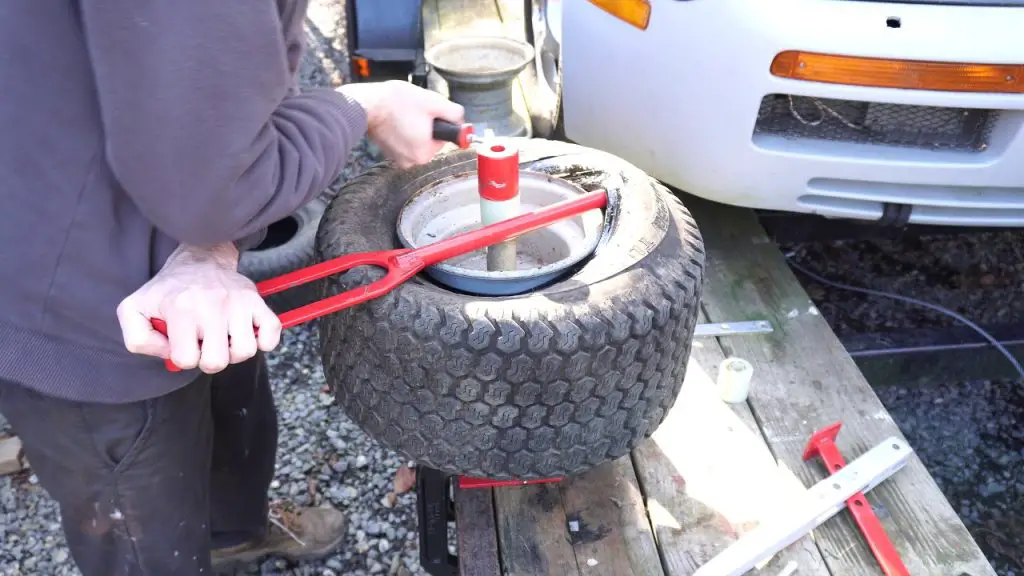by Emily Patterson
When a lawnmower tire has plenty of tread left yet has a puncture or leak, it may be less expensive to put an inner tube in the tire to extend the life of the tire. To purchase an inner tube for a lawnmower tire, get the numbers on the side of the tire and call local tire shops for price and availability. Check for any glass, nails or other debris and remove before inserting the inner tube in the tire.
Put a jack, jack stand, concrete block or other stable wedge under the lawnmower to support the lawnmower.
Remove the tire and rim from the lawnmower. Lay the wheel on a solid surface.
Wedge a crowbar and hammer between the rim and tire. Hit the crowbar with the hammer to push the tire away from the rim to break the bead. Go all the way around the rim with the crowbar and hammer to push the tire totally away from the rim. Be careful not to damage the edge of the tire or the rim.
Push the tire down where the valve stem is protruding through the rim. Use a pair of sharp snips to cut the valve stem and remove.
Use the crowbar as a wedge to carefully slide the tire, one small section at a time, over the rim so the rim is under the lip of the tire.
Sprinkle cornstarch into the tire. This will help the inner tube move freely in the tire and make it easier to maneuver into position.
Lay the inner tube on the top and position it so that the valve stem on the inner tube is in the same position as the hole for the valve stem on the rim. Push the inner tube into the the tire and push the valve stem through the hole in the rim. Use a pair of vise grips to clamp the valve stem on the outside of the rim.
Push the inner tube onto the rim with your hands and move it into position in the tire. Make sure that the inner tube is not twisted in the tire.
Wash the edge of the tire and inner edge of the rim with hot, soapy water. Do not saturate. It is easier to reseat the bead when both the tire and rim are clean.
Do not saturate. It is easier to reseat the bead when both the tire and rim are clean.
Lay the crowbar across the rim horizontally so that the hooked end can be inserted between the tire and the rim. Hook the end of the crowbar onto the rim under the edge of the tire that was removed from the rim. Be careful that you do not pinch the inner tube. Lift the end of the crowbar so the tire moves back into position on the inner side of the rim. Follow this procedure all the way around the rim, in small increments, until the entire tire has been moved back into position on the rim.
Remove vise grips from the valve stem and inflate the inner tube until the tire pushes against the rim. When the tire pushes against the rim, pour liquid dish soap between the edge of the tire and the rim. Wrap a heavy rope around the center of the perimeter of the tire and pull it tight. You can also use a clothing belt for this. The purpose of this is to push the edge of the tire as tight against the edge of the rim as possible with equal distribution all the way around. Pour more dish liquid all the way around the rim between the tire and the inner tube.
Pour more dish liquid all the way around the rim between the tire and the inner tube.
Continue inflating the inner tube until the tire is completely tight against the rim and there is no space between the edge of the tire and the rim. Deflate the inner tube and push on the tire where it meets the rim. If it pushes away from the rim, reinflate the inner tube. Repeat this process until the tire cannot move away from the rim when pressed.
Deflate the inner tube until it is inflated to the manufacturer's recommended pressure. Replace the rim on the lawnmower.
References
Tips
Things You'll Need
Warnings
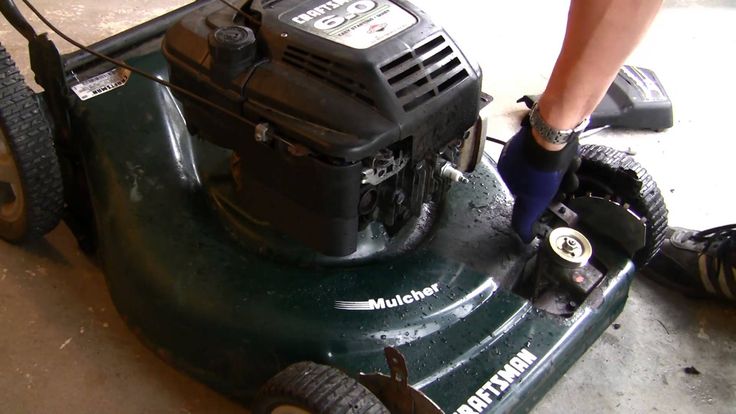 Inflate the tire only to the manufacturer's recommendation before replacing on the tire. Overinflating can cause the tire to burst.
Inflate the tire only to the manufacturer's recommendation before replacing on the tire. Overinflating can cause the tire to burst. Writer Bio
Emily Patterson has been creating content for websites since 1996. She specializes in home improvement, natural body care and natural cleaning articles. Patterson holds a computing certificate from Penn State University.
A flat lawnmower tire on a fine, sunny morning can ruin your mood. It seemed the perfect day for mowing your lawn. You have got punctures fixed several times, but things have started to get out of hands now, as the lawnmower has a flat tire again. The tube inside the lawnmower tire has been weathered because it has had various fixed punctures on its surface and needs to be replaced. This can be done easily at your home. All you need are a few tools. This article shall guide you about how you can put a tube in a lawnmower tire.
How to install a tube in a lawnmower tire, step by step:
Please keep reading the article for further elaboration on the steps mentioned above.
Contents
 2 – Step 2.2. Pull the nozzle out of the rim:
2 – Step 2.2. Pull the nozzle out of the rim: 1.1 – The tire’s size:
1.1 – The tire’s size:To complete this procedure, you will require the following equipment:
It would be best if you also have a good quality replacement tube that has the correct dimensions. Check the old tube or consult your user manual.
The first step is to remove the lawnmower’s tire, along with the rim, from the mower’s body. This is done by following the steps mentioned below:
– Step 1.1. Remove the rim’s plastic cap:At the middle of the tire’s surface is a plastic boot (or a cap).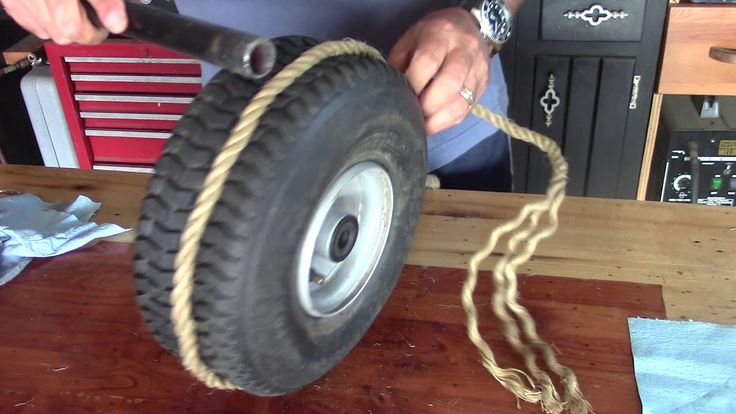 Using a pair of pliers, catch this boot, and remove it from the rim. The cap’s internal surface retains some oil or grease and is brittle. So, you need to grab the boot gently and try not to break it.
Using a pair of pliers, catch this boot, and remove it from the rim. The cap’s internal surface retains some oil or grease and is brittle. So, you need to grab the boot gently and try not to break it.
A c-clip is located behind the rim’s plastic boot. Hold that c-clip’s tab using a pair of pliers, and pull it out.
– Step 1.3. Remove the tire’s washer:Once you have removed the c-clip, you shall see a washer. Remove this washer from the lawnmower’s tire.
– Step 1.4. Pull the tire out of the axle:Pull the tire out of the lawnmower’s axle.
After removing the tire from the axle, the next step is to separate the tire from the rim to install a new tube inside the tire.
– Step 2.1. Remove the tire from one side of the rim:The tire needs to be removed from at least one side of the rim to extract the old tube’s nozzle.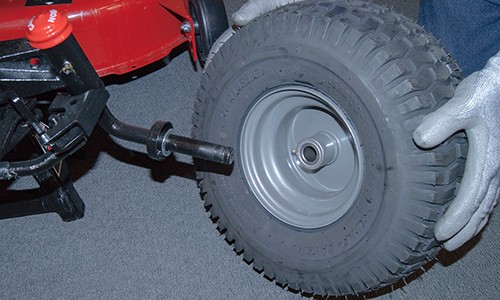
Hammer a screwdriver with a flat head at the intersection of the tire and the rim. After the screwdriver gets inside the intersection, please give it a push and try peeling the tire off the rim. Repeat the same step for the tire’s opposite side.
– Step 2.2. Pull the nozzle out of the rim:The new tube cannot be installed inside the tire until the old tube’s nozzle remains fitted in the rim. So, the next step is to pull out this nozzle from the rim.
Grab the rubber located at the nozzle’s back:At the end of the nozzle, a tiny circular rubber traps the nozzle inside the rim and keeps it jammed. Use a pair of pliers to grasp this rubber and cut it off.
Extract the nozzle out:After cutting the rubber off, use a pair of pliers to catch the nozzle’s head and pull it out in the upward direction.
– Step 2.3. Remove the entire tire from the rim:This step is the most technical one.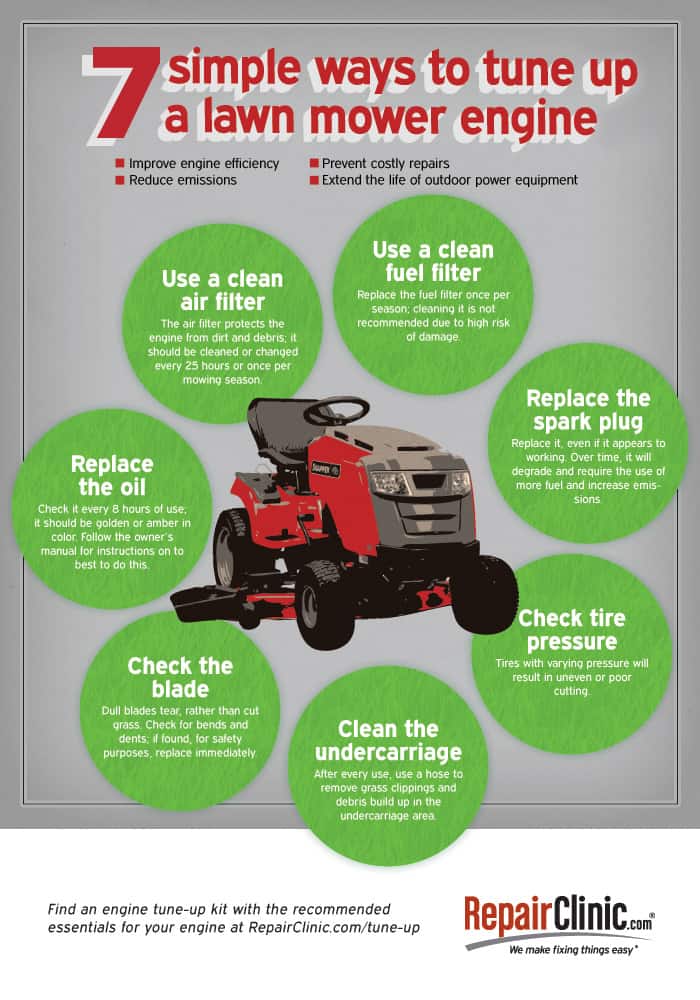 A couple of screwdrivers would be required to peel off the tire completely from the rim. While there are special tools to detach the tire from the rim, we will use screwdrivers to save some expenses.
A couple of screwdrivers would be required to peel off the tire completely from the rim. While there are special tools to detach the tire from the rim, we will use screwdrivers to save some expenses.
The tire is completely free from the rim’s grasp now. Remove this tire from the rim.
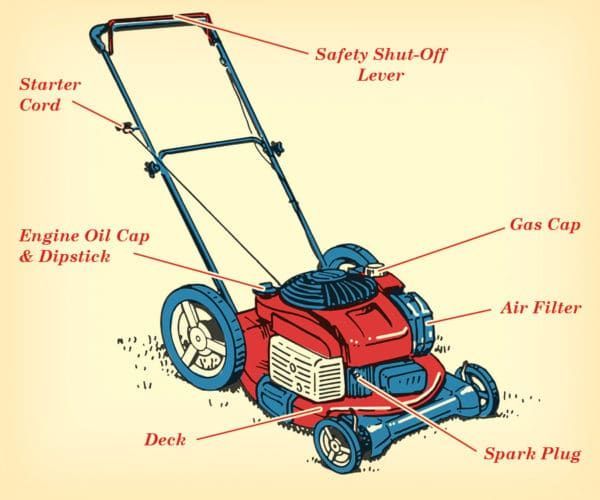 Check for any nails:
Check for any nails:Grab a torchlight and check if any nails or a sharp object is pinched inside or on the tire’s outer surface. If you find any, remove them from the tire’s surface.
After performing the steps mentioned above, you have now reached the point where you can now install the new tube inside the tire. A new tube needs to be installed if the previous one had been weathered or has had multiple punctures.
After accomplishing the main task, the next step is to reinstall the tire back on the rim. Some screwdrivers and hand force will be all that’s required for this step.
Apply transmission fluid to the internal circular edges of the tire. This is done to make the edges softer so that they fit on the rim easily. Oil can also be used in case transmission fluid is not available.
Apply pressure to one side of the tire, then attempt to force the tire inside the rim using a few screwdrivers so that the tire is crammed in on all sides.
In compliance with the tire’s prescribed air pressure, fill the tire with some air.
When the tire has been placed back on the rim, it shall now be attached to the lawnmower’s body.
Just like the way you pulled it out earlier, put the tire back on the lawnmower’s axil.
Insert the washer back into the rim of the tire.
With the help of pliers, reinstall the c-clip back into the metal rim.
Reinstall the plastic cap back on the rim.
For a hands-on demonstration of how to put a tube inside a lawnmower tire, you should watch the following video:
Related Questions:1. What points should be considered before purchase a new tube for the lawnmower’s tire?To find out what type of tube shall suit your lawnmower’s tires, a few key points should be considered, which are as follows:
The first and most important thing that needs to be considered is the lawnmower’s tire size. You cannot buy any tube just because of its superb quality and expect it to fit into your lawnmower’s tires. Normally, tire tubes are available in a size range from 2.5 inches (internal diameter) to 8 inches (outer diameter). Hence, the lawnmower tire and tube size should be kept in mind before buying a new tube.
You cannot buy any tube just because of its superb quality and expect it to fit into your lawnmower’s tires. Normally, tire tubes are available in a size range from 2.5 inches (internal diameter) to 8 inches (outer diameter). Hence, the lawnmower tire and tube size should be kept in mind before buying a new tube.
The quality of rubber determines the service life of the tube it is made from. It is recommended to buy the tube that has been made from the best quality rubber.
The lawnmower’s tire tubes cannot hold the amount of air that a 4-wheeler passenger vehicle can carry. Most of the tire tubes can hold about 30 PSI of air. But some may have less or more, depending upon the lawnmower’s manufacturing brand.
There are two types of air pressures through which air can be filled into the lawnmower’s tire tubes. One of them is through heavy-duty inflators, usually available at gas stations. In contrast, the other one is filling air through a hand-held air pump. Some of the tire tubes must be filled through heavy-duty inflators, while others can be easily filled through a hand-held gas pump.
In contrast, the other one is filling air through a hand-held air pump. Some of the tire tubes must be filled through heavy-duty inflators, while others can be easily filled through a hand-held gas pump.
Lawnmower tires may seem unimportant, but they affect the lawnmower’s mowing ability and service life. A flat tire is a result of a punctured tube, and a new one should replace the tube if it’s weathered or has had multiple punctures. All of this can now be done conveniently at your home by following the steps mentioned in this article. Don’t forget to wear protective gloves before starting the procedure to protect yourself from unnecessary injuries. The lawnmower’s other parts, such as filters, engine, spark plug, fuel quality, etc., shall also be maintained to prolong the lawnmower’s performance.
Don’t forget to wear protective gloves before starting the procedure to protect yourself from unnecessary injuries. The lawnmower’s other parts, such as filters, engine, spark plug, fuel quality, etc., shall also be maintained to prolong the lawnmower’s performance.
When purchasing a cultivator for a household or farm, they often look solely at the performance of the unit and engine power. But the running gear of the equipment has a direct impact on the efficiency of work. Each owner must clarify in advance which wheels fit of his model walk-behind tractor .
Factory walk-behind tractors are fully equipped, however, the undercarriage fails over time due to loads. It is important to have at least two pairs of spares in the bins at home wheels on the cultivator cart in order to replace the defective part in time.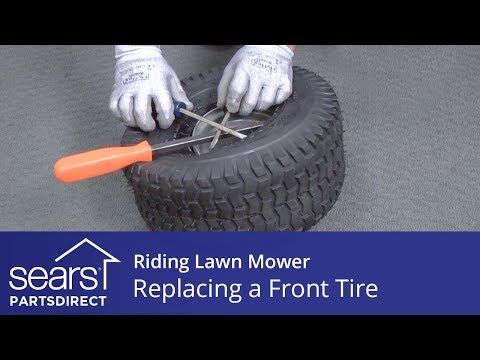
In addition to replacing worn out wheels, modernization of the running gear is often required. This must be done in the following cases:
In our store you can choose and buy top wheels for motoblock Neva and other manufacturers.
Before you decide which wheels are best for your walk-behind tractor , it is important to know about their varieties. The undercarriage for the cultivator is available in several versions:
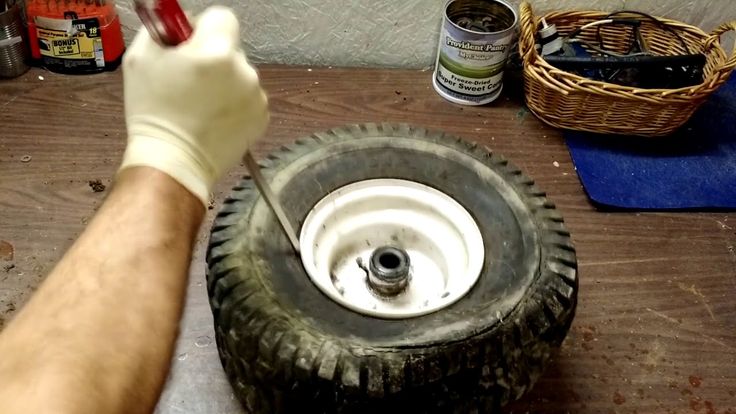 They are completed with steel elements
They are completed with steel elements In order to clarify how much wheels for a walk-behind tractor , you need to call our contact numbers or go to the catalog on the official website of the store.
When choosing wheels for the Salyut walk-behind tractor and other manufacturers, it is important to consider what land the cultivator will cultivate. For loosening clay soil or in conditions of high humidity, it is recommended to use pneumatic or soil cutters.
When choosing wheels for a walk-behind tractor with a standard size of 8 , it is important to pay attention to the following criteria:
For the primary processing of virgin soil, cast wheels of the walk-behind tractor with a size 13 are better suited.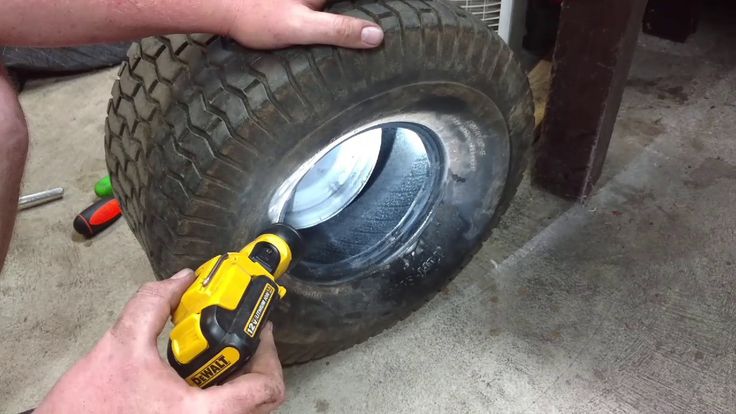 They are not equipped with an internal chamber, so they are not afraid of mechanical damage. It should be borne in mind that such a running traction has a lot of weight, therefore it is suitable for heavy walk-behind tractors.
They are not equipped with an internal chamber, so they are not afraid of mechanical damage. It should be borne in mind that such a running traction has a lot of weight, therefore it is suitable for heavy walk-behind tractors.
Our store offers a wide range of wheels for a walk-behind tractor from trusted manufacturers, including Neva . We guarantee the high quality of each unit and offer the most favorable price , because we work directly with suppliers without intermediaries.
If you have any difficulties, just call the contact numbers. Professional consultants with experience will help you choose the best model, including big wheels for the cart of the motor-block at the most favorable cost.
The driving traction must provide the cultivator with high maneuverability, while not damaging the plantings and seedlings on the site!
03/05/2013
Probably the most common cyclist failure is a tire puncture, especially if he rides in an aggressive style. Either he hit the glass, then a nail, and sometimes he just ran into the curb at speed. Experienced cyclists can change the tube in the bike with their eyes closed, but what about a beginner who can't even take off the wheel, let alone change the tube. The main thing is not to despair! If you are traveling a long distance (and always better), take a pump with you, a spare tube, or, in extreme cases, a "bike first aid kit" for the wheel. Someday she will save you from the fate of pulling the bike "on yourself".
Either he hit the glass, then a nail, and sometimes he just ran into the curb at speed. Experienced cyclists can change the tube in the bike with their eyes closed, but what about a beginner who can't even take off the wheel, let alone change the tube. The main thing is not to despair! If you are traveling a long distance (and always better), take a pump with you, a spare tube, or, in extreme cases, a "bike first aid kit" for the wheel. Someday she will save you from the fate of pulling the bike "on yourself".
So, if you punctured the wheel , first you need to get off the bike, in no case continue to move on a flat tire . Firstly, you will tear the tube even more, and secondly, you can ruin the tire, and in the worst case, the rim.
How to change the tube on a bicycle
1) If the wheel has not completely deflated, deflate it to the end, to do this, unscrew the nipple (spool) cap.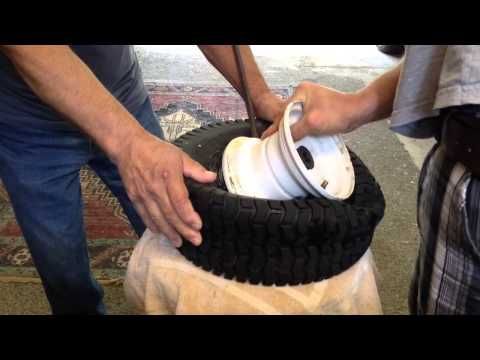 If you have a nipple (spool) the same as in the car, press something sharp on the small button in the middle and hold until the tire is flat. If you have a cap with a key for the spool, then just unscrew it. If you have a nipple (spool) like in old bicycles, unscrew the lamb and take it out.
If you have a nipple (spool) the same as in the car, press something sharp on the small button in the middle and hold until the tire is flat. If you have a cap with a key for the spool, then just unscrew it. If you have a nipple (spool) like in old bicycles, unscrew the lamb and take it out.
2) Remove the wheel. If the wheel is on an eccentric, removal will not cause difficulties, if not, then keys will be needed (depending on the bike and wheel - 13-17).
3) If you have "pliers", use them to remove the rim from the wheel, if there are no pliers, you can use an improvised tool (wrenches, etc.), but it is advisable not to use objects with a sharp edge - this can lead to damage to the tube or rim. Tear the tire with your tool and, resting it against the rim, press down until the edge of the tire comes out of the rim, then take the second key or mount and do this action again, while NOT removing the first key. When you feel that the keys do not lean back when you release them - just try to move the second key in a circle away from the first key.
4) Remove the camera by simply grasping it with your fingers. Grasp the opposite side of the nipple (spool).
5) In principle, it is possible to insert a new tube, but I recommend removing the tire completely (this can be done by hand or with tools (wrenches)).
Check the condition of the rim: there are no metal burrs inside, check the condition of the rim tape, look inside the tire. This should be done if you change cameras frequently and don't know where you might have blown a tire.
How to install a tube in a bicycle wheel
1) Take a new tube or a sealed tube (how to tape a tube), squeeze it with one hand and run it in a circle - this will help to clean it of unwanted foreign objects (rubber pieces, metal chips, etc.) .d.)
2) Lightly inflate it, if you removed the tire completely, put it on one rib (if the rubber is directional - make sure you install it correctly (you can peek at the rear wheel if the treads are the same)).